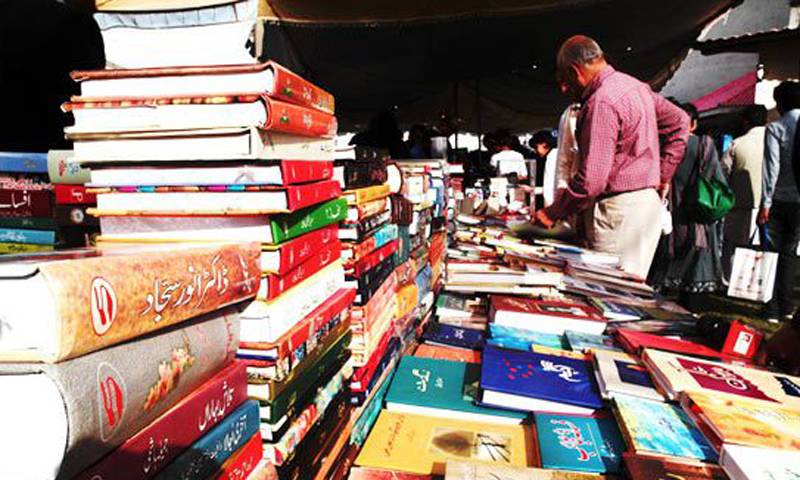
Dr Khalid Ashraf, one of the leading Urdu scholars of India, is a professor at the University of Delhi. Born in town of Ruhelkhand in Uttar Pradesh, famous for its mangoes and Urdu culture, Ashraf moved to Delhi after completing his secondary education.
He has a number of books and articles to his credit and has edited and compiled a two-volume anthology of Urdu short stories called Barresagheer Mein Urdu Afsana.
His book Barresagheer Mein Urdu Novel (1947-1993) was first published in 1993 but many subsequent editions have since been published in Pakistan and India. After reading Shamsur Rahman Faruqi’s novel Kai Chand They Sar-e-Aasman Ashraf , he was so inspired by the character of Dagh’s mother that he wrote an article titled ‘Dagh aur us ki Walda’. Currently, he is conducting research on Deputy Nazir Ahmed who, according to Ashraf, converted to Christianity for a brief period and one of his books was burnt for its idiomatic language.
A self-proclaimed progressive writer, Ashraf aims to analyze the politics behind every big Urdu novel “from a progressive angle”. He refers to Dr Qamar Rias as his guru and adds that it was Rias who introduced him to Urdu literature and encouraged him to write.
He wrote his first book in 1987 on the novelist Sarfraz Hussain. In his view, although Indian government grants are making it possible to publish many books, the real Urdu language has disappeared.
Would you like to share the names of some novelists included in Barresagheer Mein Urdu Novel?
Some of the novelists include Qurratulain Hyder, Joginder Paul, Intizar Husain, Abdullah Hussein, Mumtaz Mufti, Enver Sajjad, Fakhar Zaman, Bano Qudsia, Saira Hashmi, Jamila Hashmi, Nisar Aziz Butt and Altaf Fatima.
What is your general outlook on literature?
There is always politics in literature. You may be able to avoid politics in poetry by using Alaamatien but if you are writing fiction, grand fiction, or a grand novel, you cannot avoid politics. My method or way of analysis is to look at the hidden politics behind the novel, and discuss that. In this respect, I have found Abdullah Hussein a very powerful writer.
And how did you find his politics?
His politics was progressive. One of his novels, Nadaar Log, is entirely based on it.
How do you look at Intizar Husain?
Intizar Husain was a well-read person. He had his own politics; look at his novel Aagay Sumandar Hai, it is a political novel against the politics of Ayub Khan. Same is the case with Basti; it is about the creation of Bangladesh; how the nation was confused and perturbed and how it was unable to comprehend the situation.
He wrote for more than six decades. He started writing in 1947; his first novelette Chand Grehan was published in 1948. I feel hesitant in using this word but he did a lot of ‘recycling’ or repetition in these six decades. His columns contained lots of politics.
What was Bano Qudsia and Ashfaq Ahmed’s politics like?
Bano Qudsia’s command of language is very good. After Qurratulain Hyder, Bano Qudsia’s language is really very good. Ashfaq Sahib had also established a Sufi group headed by Qudratullah Shahab and Mumtaz Mufti (Alipur Kaa Aaili). They were Sarkari Sufis, meaning they were attached with the government. Such people are writing for government institutions day and night. You are selling words and then recycling them by selling them to radio and television.
What is Shamsur Rahman Faruqi’s politics like?
He was at one time associated with Jamaat-e-Islami and he used to edit an anti-left paper, Shabkhoon. Faruqi Sahib is a great man, he is now in his 80s and at present there is no other Alim (scholar) of his stature. After the death of his wife, Faruqi Sahib became more engrossed in the past, especially the 18th century Urdu culture.
His writing turns from fiction into a cultural thesis and it seems that he wants to teach us about tehzeeb (civilisation). My critique of the novel is that fiction should not become a research thesis or an encyclopedia. It should focus on the life of the characters.
Who are the new Urdu fiction writers in India?
Interestingly, most of the young Indian Urdu fiction writers have been hooked to magic realism of Gabriel Garcia Marquez. Abdus Samad, Ghazanfar, Musharraf Alam Zauqi, Qaim Afaqi are some names that come to mind. Some writers in Bombay include Ali Imam Naqvi and Rahman Abbas.
Abbas also has a novel that employs the magic realism technique; his new novel is titled Rohzin. Syed Mohammad Ashraf and Rahman Abbas are both producing good fiction. Syed Mohammad Ashraf wrote Daar se Bicchhre and Aakhri Sawariyan, and then there was Ali Imam Naqvi who is now dead. There is also Salam bin Razzaq in Bombay, who is a senior fiction writer.
Then, there is a professor in Jamia Milia, Khalid Javed. He is writing very powerful fiction. His recent novel Naimat Khana was written in Marquez’s style of magic realism. The famous afsanvi majmooa of Javed’s is Tafreeh ki Dopehar using magic realism.
My major concern is that larger novels, exceeding 600-800 pages, are not being produced. People don’t have the stamina that is required to complete the research and effort needed to write a big novel.
He has a number of books and articles to his credit and has edited and compiled a two-volume anthology of Urdu short stories called Barresagheer Mein Urdu Afsana.
His book Barresagheer Mein Urdu Novel (1947-1993) was first published in 1993 but many subsequent editions have since been published in Pakistan and India. After reading Shamsur Rahman Faruqi’s novel Kai Chand They Sar-e-Aasman Ashraf , he was so inspired by the character of Dagh’s mother that he wrote an article titled ‘Dagh aur us ki Walda’. Currently, he is conducting research on Deputy Nazir Ahmed who, according to Ashraf, converted to Christianity for a brief period and one of his books was burnt for its idiomatic language.
A self-proclaimed progressive writer, Ashraf aims to analyze the politics behind every big Urdu novel “from a progressive angle”. He refers to Dr Qamar Rias as his guru and adds that it was Rias who introduced him to Urdu literature and encouraged him to write.
He wrote his first book in 1987 on the novelist Sarfraz Hussain. In his view, although Indian government grants are making it possible to publish many books, the real Urdu language has disappeared.
Would you like to share the names of some novelists included in Barresagheer Mein Urdu Novel?
Some of the novelists include Qurratulain Hyder, Joginder Paul, Intizar Husain, Abdullah Hussein, Mumtaz Mufti, Enver Sajjad, Fakhar Zaman, Bano Qudsia, Saira Hashmi, Jamila Hashmi, Nisar Aziz Butt and Altaf Fatima.
What is your general outlook on literature?
There is always politics in literature. You may be able to avoid politics in poetry by using Alaamatien but if you are writing fiction, grand fiction, or a grand novel, you cannot avoid politics. My method or way of analysis is to look at the hidden politics behind the novel, and discuss that. In this respect, I have found Abdullah Hussein a very powerful writer.
And how did you find his politics?
His politics was progressive. One of his novels, Nadaar Log, is entirely based on it.
How do you look at Intizar Husain?
Intizar Husain was a well-read person. He had his own politics; look at his novel Aagay Sumandar Hai, it is a political novel against the politics of Ayub Khan. Same is the case with Basti; it is about the creation of Bangladesh; how the nation was confused and perturbed and how it was unable to comprehend the situation.
He wrote for more than six decades. He started writing in 1947; his first novelette Chand Grehan was published in 1948. I feel hesitant in using this word but he did a lot of ‘recycling’ or repetition in these six decades. His columns contained lots of politics.
What was Bano Qudsia and Ashfaq Ahmed’s politics like?
Bano Qudsia’s command of language is very good. After Qurratulain Hyder, Bano Qudsia’s language is really very good. Ashfaq Sahib had also established a Sufi group headed by Qudratullah Shahab and Mumtaz Mufti (Alipur Kaa Aaili). They were Sarkari Sufis, meaning they were attached with the government. Such people are writing for government institutions day and night. You are selling words and then recycling them by selling them to radio and television.
What is Shamsur Rahman Faruqi’s politics like?
He was at one time associated with Jamaat-e-Islami and he used to edit an anti-left paper, Shabkhoon. Faruqi Sahib is a great man, he is now in his 80s and at present there is no other Alim (scholar) of his stature. After the death of his wife, Faruqi Sahib became more engrossed in the past, especially the 18th century Urdu culture.
His writing turns from fiction into a cultural thesis and it seems that he wants to teach us about tehzeeb (civilisation). My critique of the novel is that fiction should not become a research thesis or an encyclopedia. It should focus on the life of the characters.
Who are the new Urdu fiction writers in India?
Interestingly, most of the young Indian Urdu fiction writers have been hooked to magic realism of Gabriel Garcia Marquez. Abdus Samad, Ghazanfar, Musharraf Alam Zauqi, Qaim Afaqi are some names that come to mind. Some writers in Bombay include Ali Imam Naqvi and Rahman Abbas.
Abbas also has a novel that employs the magic realism technique; his new novel is titled Rohzin. Syed Mohammad Ashraf and Rahman Abbas are both producing good fiction. Syed Mohammad Ashraf wrote Daar se Bicchhre and Aakhri Sawariyan, and then there was Ali Imam Naqvi who is now dead. There is also Salam bin Razzaq in Bombay, who is a senior fiction writer.
Then, there is a professor in Jamia Milia, Khalid Javed. He is writing very powerful fiction. His recent novel Naimat Khana was written in Marquez’s style of magic realism. The famous afsanvi majmooa of Javed’s is Tafreeh ki Dopehar using magic realism.
My major concern is that larger novels, exceeding 600-800 pages, are not being produced. People don’t have the stamina that is required to complete the research and effort needed to write a big novel.
